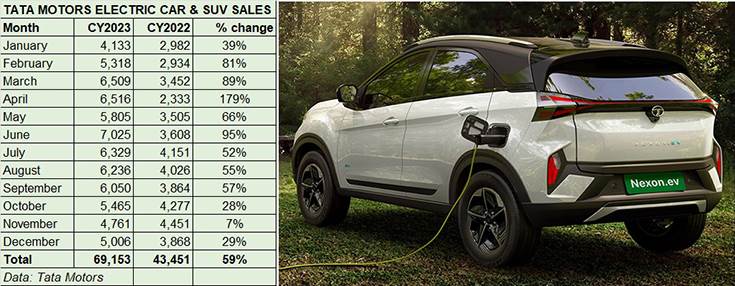Tata Motors has driven out of CY2023 with its best-ever passenger vehicle wholesales of 550,883 units, up 4.56% (CY2022: 526,978 units). A key growth enabler has been its electric vehicles (EVs) which also registered their best-ever sales in a calendar year – 69,153 units, which is a robust year-on-year increase of 62% (CY2022: 43,451 units). This smart growth has translated into a higher EV penetration for Tata Motors – its EV sales contributed 12.55% to overall PV sales, bettering the 8% in CY2022.
The month-wise wholesales split (see table below) reveals that monthly sales averaged 5,762 units in CY2023, up from the 3,720 units in CY2022. June turned out be the best month with the company exceeded 7,000 units for the first time.

June 2023 (7,025 units) turned out be the best month for Tata’s EV sales with the company exceeding 7,000 units for the first time.
Commenting on the company’s Q3 FY2024 (October-December 2023) EV performance, Shailesh Chandra, MD, Tata Motors Passenger Vehicles and Tata Passenger Electric Mobility, said: “EV sales posted a healthy growth of 21% vs Q3 FY23 (domestic + IB), led by the launch of the new Nexon EV and continuing popularity of the Tiago EV.”
Tata Motors continues to make strong gains in the fast-growing electric passenger vehicle market, where retail sales jumped 118% and crossed the 81,000-unit mark in CY2023. What has helped accelerate growth is the company expanding the addressable market with three body styles – sedan, SUV and hatchback – which cater to both the premium and mass market customer segments.
At present, its seven-model PV portfolio which comprises the Altroz and Tiago hatchbacks, Tigor sedan, and the Nexon, Punch, Harrier and Safari SUVs has all-electric variants for three models – the Nexon, Tigor (and Xpres-T EV for fleet buyers) and the Tiago. And the Punch EV is slated for a rollout soon.

Of its seven-model portfolio, Tata Motors has all-electric variants for three models – the Nexon, Tigor (and Xpres-T EV for fleet buyers) and the Tiago.
This eco-friendly trio of zero-emission cars and SUVs has helped the company reach out towards its target audience – both personal EV buyers and EV fleet buyers. While the Nexon EV continues to be the model with the maximum demand, the Tiago EV launched in January 2023 as the most affordable electric car in India has added tailwinds to sales.
While a growing number of personal buyers transition to EVs, Tata Motors continues to benefit from demand from fleet operators, who achieve substantial gains from wallet-friendly EVs as compared to petrol, diesel or even CNG-powered cars. The bulk of the sales for the Tigor EV are for the X-Pres T fleet-only EV. Interestingly, a recent company study covering 100,000 Tata EV owners, revealed that 50% of sales were generated from rural India and outside of the top 20 cities. Also, nearly a quarter were bought by first-time owners, 24% by women, and that EVs have 23% higher running than ICE vehicles.
Tata Motors, which is the EV market leader with a commanding share of over 70% at present as a result of being the first to mainstream e-PVs for the mass market, aims to have EVs comprise 50% of its portfolio by 2030.

The Punch EV, which will feature Tata’s Ziptron powertrain, is likely to be the first Tata EV to come with a charging socket mounted on the front bumper.
GETTING FUTURE-READY . . .
While the refreshed and Curvv concept-inspired Nexon.ev was launched on September 14 at Rs 810,000, Tata Motors is set to up the ante with the launch of the Punch EV early in 2024. While the sub-compact electric SUV has been spied testing previously, new spy photos reveal that the zero-emission Tata Punch EV has a charging slot on the front bumper.
The Punch EV, which will be targeted at the Citroen eC3 in India, will be positioned below the recently launched Nexon EV MR (the lower-spec variant) but above the Tiago EV.
At the Auto Expo 2023 last January, Tata had revealed its future three-phased model strategy across the Gen 2 and Gen 3 architecture. These take the form of the Curvv concept, a Gen 2 EV based on a multi-energy platform, and Avinya, a Gen 3 EV developed on an optimised, dedicated EV platform.
The company is on track to deliver 10 EVs by 2026. As is known, Tata Motors has committed an investment of US$ 2 billion (approximately Rs 16,500 crore) in its EV business starting in 2022 over a five-year period.
That’s not all. To ensure it is future-proofed on the manufacturing capacity front, Tata Motors’ recent acquisition of Ford India’s plant in Sanand, Gujarat, will help unlock additional capacity of 300,000 units per annum, expandable to 420,000 units per annum.
Driving towards sales of 75,000 EVs in FY2024
With nine months of FY2024 over, Tata Motors is on track to achieve sales of over 500,000 PVs including 75,000 EVs. In the April-December 2023 period, it has recorded cumulative sales of 415,945 PVs, up 3% (April-December 2022: 403,747 units) including 53,193 EVs, up 56% YoY (April-December 2022: 34,083 EVs).
Since the launch of the Tiago EV in January 2023, Tata Motors says it has unlocked huge potential to increase its EV sales by adding 160 more cities in its EV sales network. Having inaugurated its two flagship EV-exclusive showrooms in Gurugram on December 21, it now plans to open 50-100 more such stores across the country in the next 12-18 months. With all of 10 new all-electric product launches lined up until 2025, Tata Motors aims to be a diversified player in the passenger EV segment.
ALSO READ:
Tata Motors’ Shailesh Chandra on why EVs are technology of choice for OEMs world over
EV share of auto sales in India grows to over 6% in CY2023
Record-breaking year for electric two-wheeler sales, Ola-TVS-Ather command 62% market share
Electric 3-wheeler sales clock 66% growth in CY2023 to over 581,000 units
Electric car, SUV and MPV sales jump 114% to over 81,000 units in CY2023
